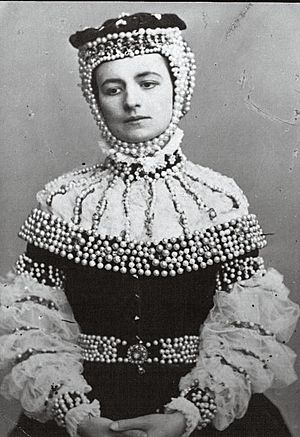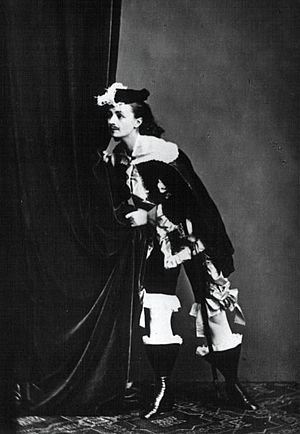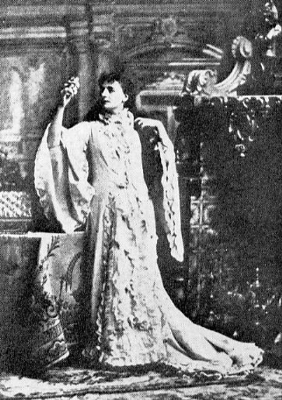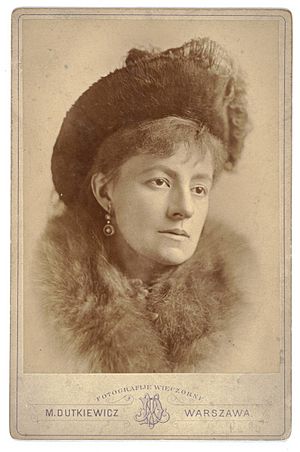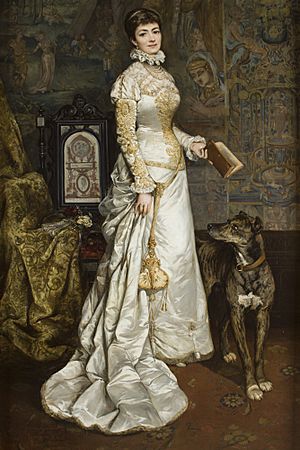Helena Modjeska facts for kids
Quick facts for kids
Helena Modjeska
|
|
|---|---|
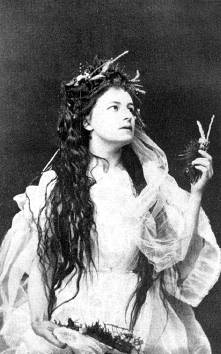
Helena Modjeska as Ophelia in Shakespeare's Hamlet, 1867
|
|
| Born |
Jadwiga Benda
(baptized Helena Opid) 12 October 1840 Free City of Kraków
|
| Died | 8 April 1909 (aged 68) |
| Spouse(s) |
Gustav Modrzejewski
(m. 1861; div. 1868)Count Karol Bozenta Chłapowski
(m. 1868) |
| Children | 2, including Ralph Modjeski |
| Relatives | Władysław T. Benda (nephew) |
| Signature | |
Helena Modrzejewska (Polish pronunciation: [mɔdʐɛˈjɛfska]), known professionally as Helena Modjeska, was a famous Polish actress. She was born Jadwiga Benda on October 12, 1840. Helena became very successful on the Polish stage. Later, she moved to the United States and also became a star in America and London, even though her English wasn't perfect at first. Many people consider her the greatest actress in the history of Polish theater. She was especially known for her roles in Shakespeare's plays and other serious, dramatic parts.
Contents
Early Life and First Steps in Acting
Helena Modjeska was born in Kraków, Poland, on October 12, 1840. Her birth name was Jadwiga Benda. She was later baptized Helena Opid, using her godfather's last name.
Helena's family background is a bit complicated. Her mother was Józefa Benda. Helena later wrote that her father was a musician named Michael Opid. However, some evidence suggests her father might have been a wealthy Polish nobleman, Prince Władysław Hieronim Sanguszko. Helena and her younger sister Josephine were mostly raised by their great-aunt Teresa.
Helena married Gustave Sinnmayer, an actor and theater director. She later found out their marriage wasn't fully legal because he was still married to someone else. They had two children: a son named Rudolf (who later became Ralph Modjeski) and a daughter named Marylka, who sadly died as a baby.
Gustave Sinnmayer used the stage name "Gustaw Modrzejewski." When Helena started acting in 1861, she took the feminine version of this name, becoming Helena Modrzejewska. Later, when she performed outside of Poland, she shortened it to "Modjeska." This was easier for English-speaking audiences to say.
In her early career in Poland, Modrzejewska performed in many smaller towns. In 1862, she acted for the first time in Lwów. There, she played "Skierka" in Juliusz Słowacki's play Balladyna, which was her first role in a Romantic drama.
In 1865, Helena left Gustave Sinnmayer and returned to Kraków with her son Rudolf. She then got a four-year acting job there. In 1868, she began performing in Warsaw. During her eight years in Warsaw, she became a huge theater star. Her half-brothers, Józef and Feliks Benda, were also well-known actors in Poland.
One event showed how strict Polish society was under Russian rule in the 1800s. At one of Modrzejewska's shows in Warsaw, some students gave her flowers with a ribbon in Poland's national colors (red and white). The Russian authorities saw this as a protest for Polish independence. The students were kicked out of school and banned from attending any other schools.
Marriage to Karol Chłapowski
On September 12, 1868, Modjeska married Karol Bożenta Chłapowski, a Polish nobleman. In America, he was known as "Count Bozenta," but he wasn't actually a count. His family belonged to the ziemiaństwo, which means they were landed gentry without a special title. He used "Count Bozenta" as a stage name to get more attention, and "Bozenta" was easier for English speakers to pronounce.
Karol Chłapowski was the editor of a newspaper called Kraj (The Country). Modjeska wrote that their home became a meeting place for artists and writers in Kraków. Poets, authors, politicians, and other creative people often visited her home.
Moving to America
In July 1876, Helena Modjeska and her husband decided to move to the United States. She had been the top actress in Polish theater for over ten years. They had both personal and political reasons for leaving Poland.
Once in America, Modjeska and her husband bought a ranch near Anaheim, California. Friends like Henryk Sienkiewicz, who later won the Nobel Prize for literature in 1905, came with them to California. Sienkiewicz wrote some of his stories during this time.
Modjeska thought she would stop acting and live a simple life on the ranch. She imagined riding horses and living among the hills. However, the reality was different. None of the group knew how to farm, and they could barely speak English. Their dream of a perfect life on the ranch didn't work out. So, Modjeska returned to acting, performing the Shakespearean roles she knew from Poland.
Becoming a Star in America
On August 20, 1877, Modjeska made her American debut at the California Theatre in San Francisco. She performed in an English version of Adrienne Lecouvreur. A theater agent named Harry J. Sargent saw her and signed her for a tour on the East Coast. She then made her New York debut.
She spent three years abroad, mostly in London, from 1879 to 1882. She used this time to improve her English before returning to the American stage. In 1880, she even helped put on a performance of Romeo and Juliet in Cornwall, England, to raise money for a church organ.
Even with her accent and not-yet-perfect English, she became very successful. During her career, she played many famous roles. These included nine Shakespearean heroines, Marguerite Gautier in Camille, and Schiller's Maria Stuart. In 1883, the same year she became an American citizen, she put on Henrik Ibsen's play A Doll's House in Kentucky. This was the first time an Ibsen play was performed in the United States. In the 1880s and 1890s, she was known as the best female actress for Shakespeare's plays in America.
In 1893, Modjeska was asked to speak at a women's conference at the Chicago World's Fair. She talked about the challenges faced by Polish women in the parts of Poland ruled by Russia and Prussia. Because of this speech, the Russian government banned her from traveling in Russian territory.
Modjeska had a stroke in 1897, which partly paralyzed her. But she recovered and returned to the stage, performing for several more years. Her last performances in Poland were from 1902 to 1903 in Lwów, Poznań, and Kraków.
On May 2, 1905, she had a special jubilee performance in New York City. She then toured for two more years and officially ended her acting career. After that, she only performed sometimes to help raise money for charities.
Helena Modjeska died in Newport Beach, California, on April 8, 1909, at age 68. Her body was sent back to Kraków, Poland, to be buried in her family's grave at the Rakowicki Cemetery.
Her autobiography, Memories and Impressions of Helena Modjeska, was published after her death in 1910. Her son, Rudolf Modrzejewski, became a famous civil engineer who designed bridges.
Lasting Legacy
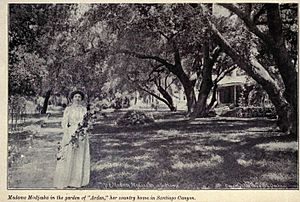
Modjeska's home from 1888 to 1906, called Arden, is now a registered National Historic Landmark.
Many places and things are named after her:
- Modjeska Park in Anaheim, California
- Helene Street in Anaheim, California
- Modjeska Canyon, California (where her home, Arden, is located)
- Modjeska Falls, California
- Modjeska Peak (a mountain in California)
- Bouquet Helena Modjeska, a perfume
- Modjeskas, a caramel-covered marshmallow candy invented in her honor in Louisville, Kentucky.
- A street in Wrocław, Poland.
- Modjeska Youth Theater Company in Milwaukee, Wisconsin
- A Pullman train car, the Helena Modjeska.
- SS Helena Modjeska, a US cargo ship.
There is also a statue of Modjeska outside the Pearson Park Amphitheater in Anaheim, California.
Helena Modjeska was the mother of the famous bridge engineer Ralph Modjeski. She was also the godmother to artist-author-philosopher Stanisław Ignacy Witkiewicz and the aunt of artist Władysław T. Benda. She was also the godmother to American actress Ethel Barrymore.
Famous Roles

Some of Modjeska's most important dramatic roles included:
- From William Shakespeare:
- Ophelia in Hamlet
- Juliet in Romeo and Juliet
- Desdemona in Othello
- Queen Anne in Richard III
- Nora in Henrik Ibsen's A Doll's House
- Luisa Miller in Salvadore Cammarano's Luisa Miller
- Friedrich Schiller's Maria Stuart and Princess Eboli
- Marion Delorme in Victor Hugo's Marion Delorme
- Victor Hugo's Tisbé
- Juliusz Słowacki's Maria Stuart and Mazeppa
She also performed in Polish versions of popular plays by other famous writers like Ernest Legouvé, Alexandre Dumas, père and fils, Émile Augier, Alfred de Musset, Octave Feuillet, and Victorien Sardou.
In Books and Stories
Susan Sontag's novel In America (1999) is a fictional story based on Modjeska's life.
Modjeska was also a character in the short novel My Mortal Enemy by Willa Cather.
Some scholars believe that Modjeska might have been the inspiration for the character Irene Adler in Arthur Conan Doyle's Sherlock Holmes stories. Irene Adler is the only woman Sherlock Holmes ever came close to loving. In one story, Doyle mentions Adler being a famous singer in Warsaw at the same time Modjeska was a top actress there. The fictional character's personality also reminds some of the real actress.
Remembering Helena Modjeska
In 2009, to mark 100 years since her death, the Historical Museum of the City of Kraków held an exhibition called "Helena Modjeska (1840–1909): For the Love of Art." This exhibition later moved to Warsaw. It included items from the Bowers Museum in Santa Ana, California.
Google Doodle
On October 12, 2021, a Google Doodle honored Modjeska to celebrate the 181st anniversary of her birth.
See also
 In Spanish: Helena Modjeska para niños
In Spanish: Helena Modjeska para niños
- Helena Modrzejewska National Stary Theater in Kraków
- List of Poles
- Modjeska House
- Starring Madame Modjeska


